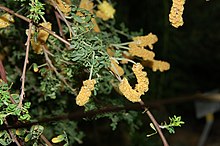Acacia drummondii
| Drummond's wattle | |
|---|---|

| |
| Scientific classification | |
| Kingdom: | Plantae |
| Clade: | Tracheophytes |
| Clade: | Angiosperms |
| Clade: | Eudicots |
| Clade: | Rosids |
| Order: | Fabales |
| Family: | Fabaceae |
| Subfamily: | Caesalpinioideae |
| Clade: | Mimosoid clade |
| Genus: | Acacia |
| Species: | A. drummondii
|
| Binomial name | |
| Acacia drummondii | |

| |
| Occurrence data from AVH | |
| Synonyms | |
|
Acacia drummondii var. typica E.Pritz[1] | |
Acacia drummondii, commonly known as Drummond's wattle, is a perennial shrub endemic to Western Australia.[1]
Description
The erect and compact shrub[2] typically grows to a height of 0.3 to 1.8 metres (1.0 to 5.9 ft)[3] and to a similar width. The branches are thin and reddish and appear close to the ground. It has mid-green to slightly bluish green ornamental foliage. The leaves face upward from the stem and are well divided but not feathery with a length of around 2.5 centimetres (1.0 in).[2] It blooms between June and October producing inflorescences with yellow flowers.[3] A single flowerspike forms per axil, the spikes are 2 to 4 cm (0.8 to 1.6 in) in length with a soft appearance with clear canary yellow scentless flowers.[2]
Taxonomy
The species was first formally described by the botanist John Lindley in 1839 as part of the work A Sketch of the Vegetation of the Swan River Colony. It was reclassified by Leslie Pedley in 2003 as Racosperma drummondii then transferred back to the genus Acacia in 2006.[4]
The species name honours James Drummond, the Government Naturalist of the Swan River Colony.[2]
Distribution
It has a disjunct distribution extending north from the Wheatbelt region south to the Great Southern region around Albany. It is found in a variety of habitat including among granite outcrops, in gullies and low lying areas and on hillsides and grows well in sandy and gravelly soils often around laterite.[3] It often forms part of the understorey in the forests and woodland communities.[2]
See also
References
- ^ a b ILDIS LegumeWeb
- ^ a b c d e "Acacia drummondii Drummond's wattle". Growing native plants. Australian National Botanic Gardens. Retrieved 12 September 2018.
- ^ a b c "Acacia drummondii". FloraBase. Western Australian Government Department of Biodiversity, Conservation and Attractions.
- ^ "Acacia drummondii Lindl". Atlas of Living Australia. [Global Biodiversity Information Facility]. Retrieved 12 September 2018.
